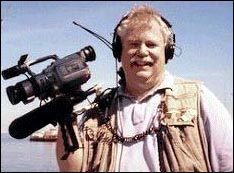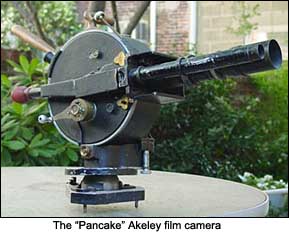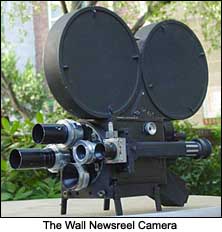Videomith
by
Steven Trent Smith
They Don't Make Them
Like They Used To
|

|
The technical history
of motion pictures and television has always fascinated me. Whenever
writing a piece for the Digital Journalist or other publications,
I always try to include some sort of perspective about the past; about
the roots of this business, the origin of the gear we use to make a
living.
An inveterate collector, over the years I've amassed a small collection
of still and movie cameras that are related to the development of photojournalism.
On the movie side, I picked up a pre-WW II Arriflex 35mm camera, revolutionary
in its day because it was the first to employ a spinning mirror to give
the camera operator a continuous through-the-lens view while actually
shooting. The post-war Eclair Camerette, interchangeable between 16mm
and 35mm, was the French response to the Arri. The Eclair helped kick
off the so-called "Nouvelle Vogue" style in the 1950's. Eclair topped
itself in the early Sixties with the NPR the first "Noiseless Portable
Reflex" camera. The introduction of the NPR, and the Swiss-made Nagra
III 1/4" synchronous portable tape recorder, gave filmmakers a
freedom they had never before experienced. And that freedom led to the
"Cinema Verite" movement.
I loved my original NPR. I bought it in 1972 with a $4,000 loan from
the Small Business Administration. The Eclair helped me kick off a career
as a documentary cameraman. In 1978, after we'd moved into video whole-hog,
the NPR was sold off. The one now in my collection came from a Christie's
auction. I paid all of $250 for it. In fact, a man from Christie's called
in panic one day. "Do you know that it will cost more to ship this thing
than what you paid for it?" I said I didn't mind. He thought I was crazy.

|

|
About 1914, Carl Akeley, a naturalist, author, artist and inventor,
decided to create his own 35mm field camera. He often traveled to exotic,
tropical locales to shoot film, usually of wild animals, but found that
the early wooden cameras simply would not hold up in the heat and humidity.
He decided to create a rugged, metal camera that would withstand the
rigors of the real world.
 The
result was what has come to be called the "Pancake Akeley," taking its
name from the round shape of its body. Everything about this new camera
was novel, if not revolutionary. A cloth shutter rotated around the
body, in a slot between the interior and exterior shells. Akeley used
lenses mounted in pairs one for taking, one for viewing. Lenses in
the shorter focal lengths were gear coupled, so that the operator could
do a "rack focus" through the viewing lens and get identical results
on the taking lens. The range of focal lengths went up to an astonishing
385mm. The camera used 200 foot, quick change magazines, designed in
a shape still familiar today. To overcome the jerkiness of the "friction"
heads used in the early days, Akeley designed a geared head that worked
on the principle of a gyro. It dampened the jerks, and made smooth shots
in the field possible. The
result was what has come to be called the "Pancake Akeley," taking its
name from the round shape of its body. Everything about this new camera
was novel, if not revolutionary. A cloth shutter rotated around the
body, in a slot between the interior and exterior shells. Akeley used
lenses mounted in pairs one for taking, one for viewing. Lenses in
the shorter focal lengths were gear coupled, so that the operator could
do a "rack focus" through the viewing lens and get identical results
on the taking lens. The range of focal lengths went up to an astonishing
385mm. The camera used 200 foot, quick change magazines, designed in
a shape still familiar today. To overcome the jerkiness of the "friction"
heads used in the early days, Akeley designed a geared head that worked
on the principle of a gyro. It dampened the jerks, and made smooth shots
in the field possible.
The camera was a huge success. Newsreel companies around the globe used
it. Famed documentarian Robert Flaherty used an Akeley to shoot Nanook
of the North.
When the talkies made it big in the late 1920's, audiences wanted not
only their features to feature sound, but their shorts and their newsreels
too. That posed an enormous technical problem. It required the development
of "silent" cameras capable of recording optical sound-on-film tracks
(those little squiggles you see along one edge of commercial movies).
One of the first to succeed was John M. Wall. His Wall Newsreel Camera
perfectly fulfilled the requirements.
 Portable
was hardly the word for the Wall. It is a big beast. The body was cast
aluminum, but with lenses, motor, sound head, magazine and film, it
must weigh over 70 pounds. It had a four-lens turret, with a built-in
viewfinder. For focusing, the entire body shifted over so the viewfinder
tube could be aligned with the taking lens. It ran off 12v, but needed
a very heavy duty battery to cope with the 50w drain. Wall cameras were
used by all the big news picture companies. Time/Life used them on its
famous The March of Time series. With the advent of television news
and the switch to 16mm, the 35mm theatrical newsreel had been phased
out in the U.S. by the mid-1960's. They survived for a few more years
in out of the way places, but by the early Seventies they were gone
for good. Portable
was hardly the word for the Wall. It is a big beast. The body was cast
aluminum, but with lenses, motor, sound head, magazine and film, it
must weigh over 70 pounds. It had a four-lens turret, with a built-in
viewfinder. For focusing, the entire body shifted over so the viewfinder
tube could be aligned with the taking lens. It ran off 12v, but needed
a very heavy duty battery to cope with the 50w drain. Wall cameras were
used by all the big news picture companies. Time/Life used them on its
famous The March of Time series. With the advent of television news
and the switch to 16mm, the 35mm theatrical newsreel had been phased
out in the U.S. by the mid-1960's. They survived for a few more years
in out of the way places, but by the early Seventies they were gone
for good.
I long thought a Wall would be perfect for the collection, but they're
awfully hard to come by. I checked E-bay religiously. A camera would
come up once every few months, but it was usually incomplete, or battered.
Then, in early June, a whole Wall sound-on-film outfit appeared on the
auction site. At the end of seven days, after some tough bidding, it
was mine.
The camera is a peach (though a rather large and heavy one). It's got
an interesting history. It was owned by Hearst Movietone. This one apparently
was used mainly in India, at least in the latter part of its working
life. I imagine it has recorded some of the most important events of
the mid-Twentieth Century. I hope someday to get it up and running.
Our lives have changed. Now a teeny little electronic gem can do the
job of a Wall or an Akeley opening up new vistas for photojournalists.
Still, I kind of miss the old days.
© 2002 Steven Trent Smith
http://www.videosmith.com
|



 The
result was what has come to be called the "Pancake Akeley," taking its
name from the round shape of its body. Everything about this new camera
was novel, if not revolutionary. A cloth shutter rotated around the
body, in a slot between the interior and exterior shells. Akeley used
lenses mounted in pairs one for taking, one for viewing. Lenses in
the shorter focal lengths were gear coupled, so that the operator could
do a "rack focus" through the viewing lens and get identical results
on the taking lens. The range of focal lengths went up to an astonishing
385mm. The camera used 200 foot, quick change magazines, designed in
a shape still familiar today. To overcome the jerkiness of the "friction"
heads used in the early days, Akeley designed a geared head that worked
on the principle of a gyro. It dampened the jerks, and made smooth shots
in the field possible.
The
result was what has come to be called the "Pancake Akeley," taking its
name from the round shape of its body. Everything about this new camera
was novel, if not revolutionary. A cloth shutter rotated around the
body, in a slot between the interior and exterior shells. Akeley used
lenses mounted in pairs one for taking, one for viewing. Lenses in
the shorter focal lengths were gear coupled, so that the operator could
do a "rack focus" through the viewing lens and get identical results
on the taking lens. The range of focal lengths went up to an astonishing
385mm. The camera used 200 foot, quick change magazines, designed in
a shape still familiar today. To overcome the jerkiness of the "friction"
heads used in the early days, Akeley designed a geared head that worked
on the principle of a gyro. It dampened the jerks, and made smooth shots
in the field possible. Portable
was hardly the word for the Wall. It is a big beast. The body was cast
aluminum, but with lenses, motor, sound head, magazine and film, it
must weigh over 70 pounds. It had a four-lens turret, with a built-in
viewfinder. For focusing, the entire body shifted over so the viewfinder
tube could be aligned with the taking lens. It ran off 12v, but needed
a very heavy duty battery to cope with the 50w drain. Wall cameras were
used by all the big news picture companies. Time/Life used them on its
famous The March of Time series. With the advent of television news
and the switch to 16mm, the 35mm theatrical newsreel had been phased
out in the U.S. by the mid-1960's. They survived for a few more years
in out of the way places, but by the early Seventies they were gone
for good.
Portable
was hardly the word for the Wall. It is a big beast. The body was cast
aluminum, but with lenses, motor, sound head, magazine and film, it
must weigh over 70 pounds. It had a four-lens turret, with a built-in
viewfinder. For focusing, the entire body shifted over so the viewfinder
tube could be aligned with the taking lens. It ran off 12v, but needed
a very heavy duty battery to cope with the 50w drain. Wall cameras were
used by all the big news picture companies. Time/Life used them on its
famous The March of Time series. With the advent of television news
and the switch to 16mm, the 35mm theatrical newsreel had been phased
out in the U.S. by the mid-1960's. They survived for a few more years
in out of the way places, but by the early Seventies they were gone
for good.